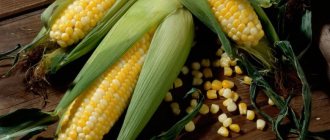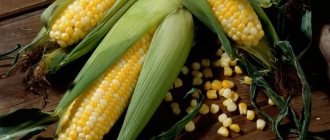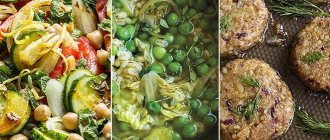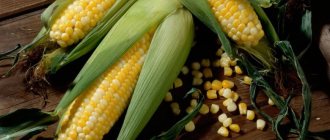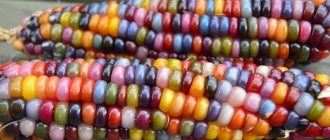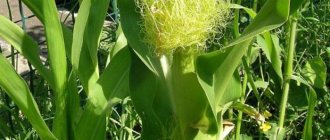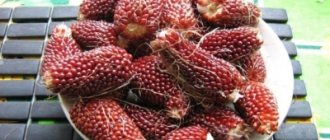Food grades stand out in the corn mosaic. We are talking about grain intended not for livestock feed, but directly for human nutrition. The production volumes of food corn in our country are an order of magnitude less than feed corn. Nevertheless, it has its niches, and the demand for certain types of corn products has been growing noticeably recently. One of the companies closely involved in the selection of food corn is the Kos-Mais research and production association, headed by Vitaly Garkushka. His publishing house “Peasant” asked him to tell us about the most popular cobs for our table.
With a "hairstyle" for the plain
Breeder Vitaly Garkushka has been working with edible white corn for 34 years. He says that he was immediately attracted by the unusual color of the cob. The culture is very popular among the peoples of the Caucasus. It is grown mainly on small plots of private household plots or peasant farms and is used for preparing porridges, baking flatbreads and other products of national cuisine. White corn flour is used in cookie and cake doughs. And in “Kos-Mais” they have adapted to add it in an amount of 20% to the dough for baking yeast bread from white flour. Thanks to this additive, says Vitaly Grigorievich, the bread does not decrease in volume, its nutritional qualities improve and the shelf life increases to a week - it does not go stale. Another important advantage of corn is that it does not contain gluten. Therefore, it is recommended for people for whom soft wheat products are contraindicated.
“We started with the Urvanskaya Belaya variety (Kabardino-Balkaria), which we “combed” to the plain - we increased the strength of the stem and the yield,” says the director of Kos-Maisa. The fact is, he explains, that Caucasian varieties were created in mountainous areas where there is little wind. The plant there did not require a strong stem that could withstand wind loads. When it was moved to the plain, and the winds here are strong, it was necessary to select lines that were more resistant to lodging.
As for yield, this task is among the main ones for all breeders. Created in Kos-Mais through many years of selection, the white corn hybrid Pearl of the Kuban combined material from Georgia, Kabardino-Balkaria, Serbia and Adygea. “That is, we have preserved the taste of local varieties, but improved the agronomic qualities, because the yield of the local variety is two times lower than that of the hybrid.”
In favorable conditions, Kuban Pearl can provide 70-80 c/ha of grain, in dry years - 50 c/ha. Agricultural technology differs little from conventional corn. But the seeding rate should be kept lower, emphasizes Vitaly Garkushka.
– We recommend no more than 40 thousand plants, due to the fact that the Rostov region, and the Stavropol and Krasnodar territories are becoming increasingly arid. This is the first reason, argues the director of the NGO. – Secondly, the hybrid retains its tendency to lodging, although it is resistant compared to varieties. Therefore, to guarantee it is better to reduce the seeding rate.
Since white corn is more cold-resistant due to its mountain origin, it can be sown a week earlier than regular yellow dent corn. In flat areas it can be grown where FAO 150 hybrids ripen. This is a mid-season variety.
Vitaly Garkushka calls the white corn market undeveloped. Nevertheless, they buy not only seed material and not only for the Caucasus republics. For example, Moscow restaurants order decent amounts of corn flour to prepare Caucasian dishes.
What is white corn
This is a plant with an ear containing a large number of white grains. Thanks to the many years of work of breeders, more than two thousand of its varieties are known in the world . It comes not only white, but also yellow, as well as with colored grains.
It was brought to Russia from South America . It gained popularity among Europeans due to its soft structure and grains, which have a sweet and pleasant taste. The most common variety in Russia is the yellow variety, but the white one is rapidly gaining ground.
Characteristics and description
Externally, all varieties of corn are similar, the only difference is the color of the grains . White has a powerful stem that reaches a height of 1.5-2.5 m. The leaves are light green, similar to long ribbons.
The leaf blade grows up to 10 cm wide . The rhizome of the crop is well developed, consisting of a lobe and nearby growing roots. It differs from other varieties by the white grains on the cob. The average weight of one cob reaches 200-300 g.
Attention! Due to its sweetish taste and soft structure, white corn is consumed not only raw, but also boiled and used for preservation.
Compound
White corn contains a large number of microelements that have a positive effect on the human body. The cobs contain easily digestible protein. The grains have a higher amount of plant protein than other cereal plants.
This protein is necessary for people who have completely eliminated meat products from their diet. It is absorbed by the body faster than that contained in meat.
The grains contain such useful microelements and vitamins:
- PP;
- A;
- B1;
- B9;
- E;
- D;
- TO;
- choline;
- beta-carotene;
- carotenoids;
- potassium;
- phosphorus;
- sulfur;
- magnesium;
- chlorine;
- calcium;
- magnesium;
- boron;
- vanadium;
- titanium;
- selenium;
- tin;
- manganese;
- chromium.
Interesting things on the site:
Colored corn - reality or photoshop
Black corn: properties and applications
The difference between white corn and yellow corn
Most varieties of white corn are sweet varieties , and yellow corn is often used for preparing feed mixtures, oil, etc. White varieties are harvested unripe, while yellow varieties are harvested only when ripe.
White appeared as a result of a mutation of yellow , in which the ratio of sugar is several times higher than starch.
Sweet corn is mainly consumed fresh or after processing with boiled water. As white corn grows on the stalk, it curls into layers of green and white husks . Its grains contain more water than yellow varieties. The grains and milk that are present in it have the same color, while in the yellow one they are yellowish in color.
As the kernels of white corn mature, they also become tough and hard , which is associated with a decrease in the amount of water in the kernels. Yellow has more nutrients and beneficial substances than its white counterpart. It contains lute and other trace elements that its white “brother” does not have.
Seeds
To grow white corn in a plot, select several already planted and healthy bushes to later collect seed from them. It is better to choose for seeds the cobs that were among the first to appear on the bush, and cut off the remaining ovaries with pruning shears so that they do not take away the strength of the seedling. In this case, all useful components will accumulate only in this cob.
To obtain high-quality seed , pay attention to the maturity of the grains. White corn is consumed fresh, but it is not suitable for breeding - you need to wait until it is biologically mature. It is not difficult to understand that corn is ripe - this happens in September.
White corn is suitable for seed collection if :
- its stem and foliage dry out and turn yellow;
- the grains become hard, and when you press on them, the milk does not come out.
Beneficial features
People who consume white corn regularly report improved health and appetite . The microelements included in its composition (magnesium, sodium, calcium, fluorine, etc.) are indispensable for the full functioning of the human cardiovascular and musculoskeletal systems, and carotenoids are for eye health.
Corn porridge and young cobs of the plant are considered useful . Canned products are also consumed, but when purchasing, pay attention to the expiration date.
White corn has a positive effect on the body:
- helps cope with anemia;
- improves digestion;
- promotes the full growth and development of the child;
- cleans blood vessels;
- helps cope with nervous disorders and stress;
- increases reproductive function in women and men;
- slows down the aging process of the skin, removes skin pigmentation.
Hybrid phenomenon
The corn hybrid SI Phenomenon has a medium-early harvest ripening period. They are grown to produce animal feed, as well as grains. The grains are tooth-shaped, orange in color, and have a starch content of 72%. The plant exhibits high disease resistance.
Other characteristics of the Phenomenon hybrid include: large cobs with a large number of rows, grains quickly give up moisture during the ripening process, the root system develops quickly. The plant exhibits high resistance to drought, frost, and lodging.
Features of cultivation
It is recommended to grow white corn in loose soil with good air and moisture permeability. The plant needs feeding and fertilizers, especially at the time of cob formation. Seeds are planted in the soil only after the soil has warmed to a depth of +10°C.
At lower temperatures, seedlings appear unfriendly , and sometimes even rot in the ground without sprouting. White corn does not need daily watering and thrives in dry and hot weather. It is better to sow seeds in a well-lit place, then both the leaf blade and the cobs will form faster, and the yield will be much higher.
The best varieties
The most popular varieties of white corn include:
- Mermaid . This is a mid-season variety. It grows 170–190 cm in height and has a cone-shaped cob. The weight of one is 200–350 g. This variety tolerates drought well and is resistant to diseases.
- Snow White (pictured). An early variety, the ripening of the cobs occurs after 73–80 days. The bush reaches a height of 2 m. The cobs are cylindrical, 15–20 cm long, weighing 200–300 g. The grains have a rich white color.
- The Snow Queen . Its features are the non-standard size of the cobs and high yield. This variety is mid-season; it takes 90–100 days for the fruit to ripen. The cobs have a cylindrical shape, grow up to 35 cm in length, and each weighs more than 300 g.
- Medunka . Belongs to early-ripening varieties of white corn, ripens in 70–75 days. The height of the bush reaches 2 m, the shape of the cobs is cylindrical, the weight of each fruit is 200–300 g. Medunka tolerates temperature changes and heat well.
Comparative table of sweet corn varieties and hybrids
| Name of variety/hybrid | Manufacturer country | Labeling by sweetness level | Ripening time , days | Head length, cm | Bean color |
| LS 889 (LS 899) F1 | International selection | Sh2 | 83-85 | 23-25 | Light yellow |
| LS 779 (LS 779) F1 | International selection | Sh2 | 75-78 | 24-26 | Light yellow |
| Sweetcorn | International selection | Sh2 | 78-82 | 23-25 | Light yellow |
| Caramello F1 | Türkiye | Sh2 | 59-65 | 24 | Light yellow |
| Vega F1 | Türkiye | Sh2 | 70-75 | 20-24 | Light yellow |
| Baron F1 | Türkiye | Sh2 | 61-67 | 18-22 | Light yellow |
| Dobrynya F1 | USA | Sh2 | 70 | 24-25 | Light yellow |
| Overland F1 | Switzerland | Sh2 | 83 | 22 | Light yellow |
| Daenerys F1 (Barcelona F1) | Ukraine | Sh2 | 65-68 | 20 | Light yellow |
| Ramondia F1 | Czech | Sh2 | 65-70 | 19-23 | Bicolor |
| Megaton F1 | USA | Sh2 | 84 | 25 | Light yellow |
| Squeegee F1 | France | Sh2 | 72-73 | 18-22 | Bicolor |
| Aloysia F1 | Czech | Sh2 | 75 | 20-21 | Light yellow |
| Rotterdam F1 | Ukraine | Sh2 | 66-69 | 20-23 | Light yellow |
| Snow White F1 | Ukraine | Sh2 | 80-85 | 18-20 | White |
| Luminox F1 | Czech | Sh2 | 65-70 | 19-21 | Light yellow |
| Spirit F1 | Switzerland | Su | 68 | 22 | Light yellow |
| Brusnitsa (Bryusnitsa) | Ukraine | Se | 82-90 | 18-20 | Light yellow |
| Dimax F1 | Türkiye | Se | 80-85 | 24-28 | Light yellow |
| Perfecta F1 | Czech | Su | 85-90 | 20-22 | Light yellow |
Now you know which varieties of corn show good results when grown in Ukraine. We are waiting for your comments under the article with reviews and experience in growing these varieties of corn.
If you find an error, please select a piece of text and press Ctrl+Enter.
Application
White corn is eaten, grown for livestock feed, and oil is made from it . It is also used in cosmetology, animal husbandry and industry.
In cooking
White corn is loved and consumed all over the world:
- boiled with cobs;
- dried;
- frozen;
- in the form of popcorn.
is also used to make flour, butter and starch .
In folk medicine
White corn is used in folk medicine:
- used as a choleretic agent;
- as part of medications to stop bleeding;
- in the form of an infusion for liver diseases;
- for weight loss and the fight against obesity;
- in the treatment of diabetes, pancreatitis and urolithiasis.
Dentoform and semidentate
Late-ripening varieties of cereals Syngenta, Krasnodar 436 cannot boast of lush greenery, but have large cobs. Tooth corn grains have an elongated shape, with a hollow at the very top that is barely noticeable.
Varieties of this crop variety with high yields include Sterling, Dneprovsky 172 MV. Semi-dent corn is produced by crossing with flint maize. The yellow and white seeds of the cereal are eaten, used as cattle feed, and poultry eat them with pleasure.
Contraindications
If corn is placed in a can, a reaction of water and iron occurs inside . Regular use of such a product disrupts the functioning of internal organs. Hepatitis, cirrhosis, diabetes, arthritis and malignancies may develop.
Doctors do not advise consuming white corn for people suffering from :
- thrombosis and increased blood clotting;
- individual intolerance to components;
- gastrointestinal diseases - gastritis, stomach ulcers;
- obesity.
People who are watching their weight and on a diet are not recommended to consume corn in any form . It is considered a high-calorie product: 100 g contains 90 kcal.

